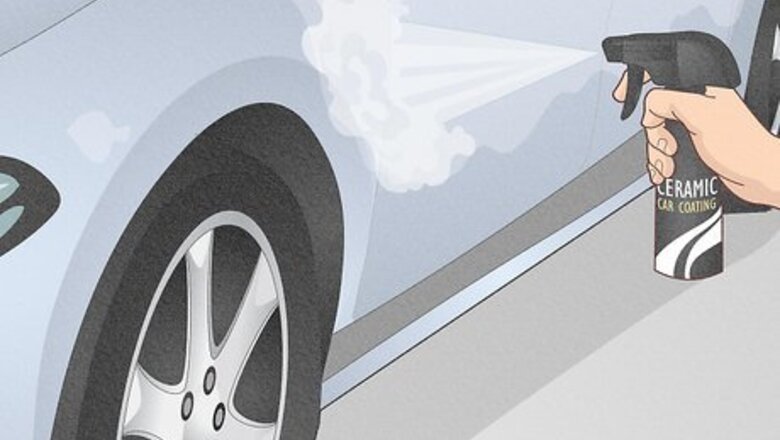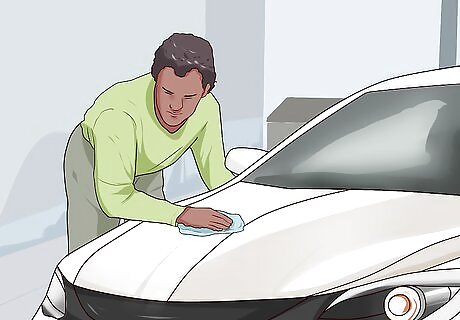
views
What is ceramic coating?

Ceramic coating is a protective layer of (you guessed it) ceramic. Ceramic coating is a glaze you apply to a vehicle’s paint, glass, rims, and trim to protect it. It’s called ceramic coating because it’s made of a silicone-based resin that’s also used to make ceramic tile, although the variant used on vehicles is colorless. Ceramic coating is often confused with car wax or sealant. While ceramic coating performs a similar duty, it is much stronger and lasts for way longer than other products. Ceramic coating is not a type of paint—it goes on over the paint. However, detailers, painters, and dealers will often offer ceramic coating whenever you get a paint job done to protect it.
Ceramic Coating Beneftis

It protects your paint from UV damage. This is why ceramic coating is so popular—it seriously keeps the sun out and ensures your paint looks brand new. Over the years, as the sun beats down on a vehicle, it washes out the paint and strips it of its vibrancy. Not if you have ceramic coating, though! That clear layer is UV-resistance so your paint will always look new. The same properties that give ceramic coating its UV resistance also give paint that shiny, sleek look associated with ceramic coating.
It keeps chemical stains and salt marks off of your paint. Your vehicle’s paint job won’t be susceptible to salt, tree sap, acid rain, and other stains. The ceramic layer will prevent any kind of chemicals from penetrating the paint and creating discoloration or damage. If you do a lot of off-roading or you live in a city that salts its roads for winter, the benefits of the ceramic coating will be especially noticeable.
It makes washing and cleaning your car a lot easier. All of ceramic coating’s protective properties mean that there won’t be dirt or debris buildup in the paint, so when you wash your car it’ll be a breeze. Ceramic coating also has a slick texture, so scrubbing or hand-washing your vehicle won’t require a ton of elbow grease on your part.
It helps wick water off of the surface of your car when it rains. A ceramic coating layer will cause water to bead up. This is mainly beneficial if you apply the coating to your vehicle’s glass. It’s a lot easier to see out of a windshield if the water beads up quickly when it rains, but it also looks pretty good on a paint job even if you skip the glass.
It creates a flashy and attractive glossy finish. Look, for a lot of car lovers the big benefit of ceramic coating is that it’s just incredibly sexy. It gives your vehicle this candy sheen that you really can’t achieve with wax. If you know deep in your heart that you want to turn some heads when you’re out on the road, ceramic coating is for you.
Ceramic Coating Limitations

It can’t protect your paint from scratches. Anybody claiming that a certain type or brand of ceramic coating protects against chips or scratches is overpromising the benefits of a ceramic coating finish. Ceramic coating is not nearly thick enough to prevent direct, physical damage to your paint. There is a product out there called paint protection film (PPF) that is sort of like a vinyl wrap that covers your paint and protects it from scratches, but that’s a completely different product from ceramic coating.
It won’t keep water spots off your car’s finish. While ceramic coating does prevent water from pooling up on the surface of the vehicle, it won’t prevent the minerals in rain or hose water from leaving water spots on your car. Don’t let water sit on your vehicle if you want to avoid water spots.
It can’t prevent the need for regular maintenance or cleaning. Ceramic coating is not a get-out-of-jail-free card for car washes. You still need to regularly clean your vehicle and perform the necessary body maintenance to ensure your ceramic coating fails.
How long does ceramic coating last?
Ceramic coating typically lasts around 2-5 years. However, some coatings can last up to 10 years if you take really good care of your car and you park indoors. But generally speaking you can expect a coating to last around 5 years. Most ceramic coating products also require regular reapplication (usually on a yearly basis). If you skip any reapplications, you can expect the coating to not last as long. A lot of car enthusiasts report the water-wicking properties of ceramic coating dissipating earlier than the other properties.
Is ceramic coating worth it?

If you care deeply about the look of your car it’s worth it. Depending on the size of your vehicle and how much protection you want, you’re looking at about $750-1,500 for ceramic coating. That’s a good chunk of change, but you get premium protection for that money, and it should last for years to come. That shiny, glossy finish also can’t be replicated by regular waxing, so if you really care about the aesthetics and protection of your vehicle then ceramic coating is worth it. You can typically cut costs in half by coating the paint by skipping the glass, wheels, and trim. The paint is really the key thing you care about most of the time.




















Comments
0 comment